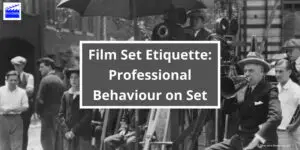A logline simply and clearly summarises a film’s central story, using only one easily-understood sentence.
As a filmmaker, whether for fiction, documentaries, short films, or commercials, the central heart of the story must be written into a logline. That allows you to effectively summarise the storyline for getting pitches booked, attracting lead actors, casting briefs, film festival entries, advertising, and release notes.
What is a Logline?
A logline is a one-sentence summary or description of a movie, television show, short film, or book that states the central conflict of the story. Loglines distil the important elements of your screenplay—main character, setting, and core conflict—into one succinct sentence.
A good logline is short, sharp, and sells your story. It should hook the reader in and make them want to learn more about your project.
Crafting an effective logline requires you to think carefully about your story’s structure and characters and then condense it into a single line that captures its essence.
The logline comes before any query letter, pitch, or casting detail.
How to Craft an Effective Logline
Key Points
Length
The ideal logline is about 25 words long.
Identify the foundation parts of the story
1. Protagonist
2. Story goals
3. Antagonist
4. Stakes
Keep it
- Simple
- Clear
- Concise
- Creative
Anyone listening to the logline must understand what kind of movie it is, so use language carefully to convey tone.
Subplots, character arcs and detail are used for pitches, and should not appear in the logline.
Protagonist
The Protagonist is the main character or group of characters. They will be the ones the audience is rooting for.
For the logline, pick the most relevant aspect of the protagonist’s life.
Perhaps it’s their job, perhaps it’s their nationality, maybe the story is being crafted out of something about their personality or life situation.
So for example, their job could be a taxi driver in New York, or screenwriter, and this job is central to the story because it has a significant impact on the story goal and source of conflict.
Their nationality could be important if, for example, they are on the maiden voyage of the Titanic, or a foreigner stuck in a situation where nationality is potentially life-threatening.
Their personality could be naive, confident, carefree, or hapless, which is worth mentioning if it helps explain the conflict.
Life situations can also be a central part of the story. A suburban father, a slave, a small town High School kid, all have obvious conflicts which can be brought into the story.
Story Goals
What does the character want? What will make them happy?
If it’s a soldier sent on a dangerous mission, they want to complete the mission and come back alive.
A slave wants freedom, and to be with those they love.
A suburban father or High School kid want to be happy, though the vision of what will bring happiness will be different.
By the end of a romance, the leading couple want to live happily after ever.
Antagonist
Your leading character, the protagonist, needs an antagonist.
You could state this simply as a goodie needs a baddie. But sometimes the protagonist is a serial killer, drug dealer, or thief planning a heist.
The antagonist is the central character providing conflict, stopping the protagonist having an easy route to their story goal.
Usually the protagonist is a person, such as a villain, an ex-boyfriend, a boss, a horrible father. Sometimes it’s a regime, maybe some form of government with soldiers, an organised crime syndicate, or aliens attacking Earth.
Stakes
The stakes must be explained or implied by the logline.
So ‘a listless and alienated teenager decides to help his new friend win the class presidency in their small town’ implies that the usual High School stakes are at play, with embarrassment, humiliation and friendship at risk.
When ‘an FBI cadet must seek help from an incarcerated and manipulative killer to rescue his wife from an organised crime dynasty’ we know lives and freedom are at stake.
Logline from Argo
Argo was an Oscar-winning 2012 Warner Bros Pictures feature film.
The logline has 24 words.
“A CIA Specialist concocts a covert operation to produce a fake Hollywood movie to rescue six American diplomats during the 1979 Iranian hostage crisis.”
Interesting character: A CIA Specialist concocts a covert operation
Goal: to produce a fake hollywood movie to rescue six american diplomats
Antagonism: during the 1979 iranian hostage crisis
Stakes: Lives are at stake
Tips To Writing a Logline
Writing an effective logline is essential to help capture the essence of your story. A good logline should include the main character, the conflict, and the stakes. It should be succinct, yet still capture the attention of readers. When crafting your logline, start with your main character and then move into the conflict. You should also include a few adjectives to help bring your protagonist to life for readers. Finally, make sure to include the stakes in your logline – this will grab readers’ attention and show them why they should root for your main character. All in all, an effective logline should be short and sweet, but still capture all the key elements of your story.
When crafting a logline, there are a few tips to keep in mind that can help make sure it is effective. First, it should be concise and attention-grabbing. Loglines should be short and to the point, while still conveying the story’s key elements. Secondly, it is important to avoid character names as much as possible. Character names can be substituted with pronouns or descriptions. Thirdly, active and visual language can help create an image of what the story will look like on-screen. Finally, it is important to include the protagonist’s goal, the antagonist they are struggling against and what is at stake in the story. When all of these elements are included in a logline, readers will have a clear picture of what the story is about and what makes it unique. It is also helpful to use irony when writing a logline as this can add an interesting twist to the story that will draw people in. By following these tips and avoiding common mistakes when writing a logline, writers can ensure their stories will stand out from the crowd.
Common Mistakes When Writing a Logline
Mistakes to Avoid with Loglines
Stopping at the setup
Some writers might not provide enough hints of what the story is about, thinking the job is done when the set up is revealed.
It’s not enough to say the story is about the patriarch of an organised crime syndicate. Where is the story in that? Perhaps it’s a comedy, where the patriarch takes part in a simple heist that goes wrong, or a deep story about an ageing patriarch who transfers control of his clandestine empire to his reluctant son.
Not having enough to sustain movie
When you reveal the protagonist, story goal, conflict, and stakes, is there enough to tell a movie-length story and keep everyone engaged?
Make the reader anticipate what will happen next.
Too much detail
Putting story arcs, subplots and too much detail quickly overwhelms a logline and makes it confusing.
You’ll need that level of detail by the time you are at pitches, but not for the logline.
Often, beginners make the mistake of writing their loglines as one long, convoluted sentence, pulling in too much detail. This can be confusing and hard to follow. Savvy writers keep their logline to about 25 words, yet still carry a hint of anticipation and mystery.
No clear antagonist
The antagonist doesn’t need to be a person, but there does need to be someone or something that created conflict and stops the protagonist reaching their story goal too quickly. The logline needs to identify what that conflict is.
Why is a Logline Important?
A logline is an important tool for financing, writers, producers, and directors.
It gives everyone a brief overview of the story in just a few words. It’s the first impression potential buyers get of the project, making it essential for a script to stand out in the crowded marketplace.
Loglines also help writers to stay focused on the main characters and their motivations throughout the writing process. Furthermore, using a logline template can help keep projects on track and make sure that all the necessary elements are included in the script.
Later, the logline helps with the casting process, the art department purchases, the marketing, film festival entries, and ultimately the audience’s interest in seeing the production.
In short, loglines provide an invaluable way to quickly capture the essence of a story and get potential producers interested in it.
The Different Lengths of Loglines
When it comes to crafting a logline for your story, you’ll want to keep the length in mind. Common industry practice dictates that loglines should be no more than one sentence long, with many screenwriting advisors capping loglines at 30 words.
That said, it is possible to have a logline that consists of one or two clear, concise sentences and a word limit of around 35 words. The key is to hover around 25 words to get the most out of your logline without making it too long-winded.
Using Loglines for Storytelling
Using loglines for storytelling is a great way to capture the attention of your audience. Loglines are short and to the point, but they can also provide a powerful insight into the story you’re telling. They can help create an emotional connection between your characters and the audience, as well as foreshadow upcoming plot points. Loglines can also be used to add suspense and intrigue, hinting at what’s to come without giving away too much of the story. By presenting your story in one sentence, you can easily engage readers or viewers and draw them into the world you’ve created. Loglines can also be used to introduce characters, setting up their motivations and goals in a succinct way. Ultimately, loglines are a great tool for communicating the essence of your story quickly and effectively.
In conclusion, loglines are an essential part of any story. They provide the reader with a concise summary of the story and help to focus on the most important elements. Crafting an effective logline can be difficult, but it is a valuable skill. When writing a logline, it is important to keep it clear and engaging.
You may also like
- Low Budget Filmmaking: More for Less
- Lighting Department Film Roles
- Shooting An Interview
- Documentary Editing
- What is Sound Design in Film?
- Color Grading for Documentary Series or Film
- Film Set Etiquette: Professional Behaviour on Set
- Observational Documentaries And Their Impact
- Essential Skills for Film Industry Professionals
- How to Create a Storyboard in 6 Simple Steps












